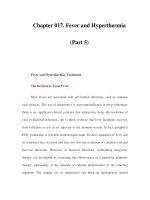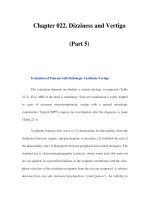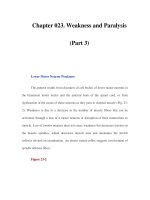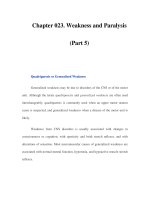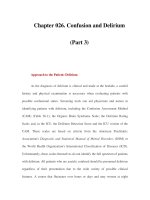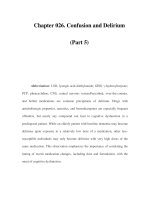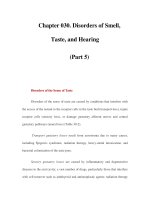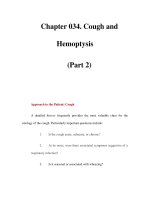Chapter 034. Cough and Hemoptysis (Part 5) ppt
Bạn đang xem bản rút gọn của tài liệu. Xem và tải ngay bản đầy đủ của tài liệu tại đây (50.21 KB, 7 trang )
Chapter 034. Cough and
Hemoptysis
(Part 5)
Approach to the Patient: Hemoptysis
The history is extremely valuable. Hemoptysis that is described as blood-
streaking of mucopurulent or purulent sputum often suggests bronchitis. Chronic
production of sputum with a recent change in quantity or appearance favors an
acute exacerbation of chronic bronchitis. Fever or chills accompanying blood-
streaked purulent sputum suggests pneumonia, whereas a putrid smell to the
sputum raises the possibility of lung abscess. When sputum production has been
chronic and copious, the diagnosis of bronchiectasis should be considered.
Hemoptysis following the acute onset of pleuritic chest pain and dyspnea is
suggestive of pulmonary embolism.
A history of previous or coexisting disorders should be sought, such as
renal disease (seen with Goodpasture's syndrome or Wegener's granulomatosis),
lupus erythematosus (with associated pulmonary hemorrhage from lupus
pneumonitis), or a previous malignancy (either recurrent lung cancer or
endobronchial metastasis from a nonpulmonary primary tumor) or treatment for
malignancy (with recent chemotherapy or a bone marrow transplant). In a patient
with AIDS, endobronchial or pulmonary parenchymal Kaposi's sarcoma should be
considered. Risk factors for bronchogenic carcinoma, particularly smoking and
asbestos exposure, should be sought. Patients should be questioned about previous
bleeding disorders, treatment with anticoagulants, or use of drugs that can be
associated with thrombocytopenia.
The physical examination may also provide helpful clues to the diagnosis.
For example, examination of the lungs may demonstrate a pleural friction rub
(pulmonary embolism), localized or diffuse crackles (parenchymal bleeding or an
underlying parenchymal process associated with bleeding), evidence of airflow
obstruction (chronic bronchitis), or prominent rhonchi, with or without wheezing
or crackles (bronchiectasis). Cardiac examination may demonstrate findings of
pulmonary arterial hypertension, mitral stenosis, or heart failure. Skin and
mucosal examination may reveal Kaposi's sarcoma, arteriovenous malformations
of Osler-Rendu-Weber disease, or lesions suggestive of systemic lupus
erythematosus.
Diagnostic evaluation of hemoptysis starts with a chest radiograph (often
followed by a CT scan) to look for a mass lesion, findings suggestive of
bronchiectasis (Chap. 252), or focal or diffuse parenchymal disease (representing
either focal or diffuse bleeding or a focal area of pneumonitis). Additional initial
screening evaluation often includes a complete blood count, a coagulation profile,
and assessment for renal disease with a urinalysis and measurement of blood urea
nitrogen and creatinine levels. When sputum is present, examination by Gram and
acid-fast stains (along with the corresponding cultures) is indicated.
Fiberoptic bronchoscopy is particularly useful for localizing the site of
bleeding and for visualization of endobronchial lesions. When bleeding is
massive, rigid bronchoscopy is often preferable to fiberoptic bronchoscopy
because of better airway control and greater suction capability. In patients with
suspected bronchiectasis, HRCT is the diagnostic procedure of choice.
A diagnostic algorithm for evaluation of nonmassive hemoptysis is
presented in Fig. 34-2.
Figure 34-2
An algorithm for the evaluation of nonmassive hemoptysis. ENT, ear,
nose, and throat; GI, gastrointestinal; CT, computed tomography.
Hemoptysis: Treatment
The rapidity of bleeding and its effect on gas exchange determine the
urgency of management. When the bleeding is confined to either blood-streaking
of sputum or production of small amounts of pure blood, gas exchange is usually
preserved; establishing a diagnosis is the first priority. When hemoptysis is
massive, maintaining adequate gas exchange, preventing blood from spilling into
unaffected areas of lung, and avoiding asphyxiation are the highest priorities.
Keeping the patient at rest and partially suppressing cough may help the bleeding
to subside. If the origin of the blood is known and is limited to one lung, the
bleeding lung should be placed in the dependent position, so that blood is not
aspirated into the unaffected lung.
With massive bleeding, the need to control the airway and maintain
adequate gas exchange may necessitate endotracheal intubation and mechanical
ventilation. In patients in danger of flooding the lung contralateral to the side of
hemorrhage despite proper positioning, isolation of the right and left mainstem
bronchi from each other can be achieved by selectively intubating the nonbleeding
lung (often with bronchoscopic guidance) or by using specially designed double-
lumen endotracheal tubes. Another option involves inserting a balloon catheter
through a bronchoscope by direct visualization and inflating the balloon to
occlude the bronchus leading to the bleeding site. This technique not only prevents
aspiration of blood into unaffected areas but also may promote tamponade of the
bleeding site and cessation of bleeding.
Other available techniques for control of significant bleeding include laser
phototherapy, electrocautery, bronchial artery embolization, and surgical resection
of the involved area of lung. With bleeding from an endobronchial tumor, argon
plasma coagulation or the neodymium:yttrium-aluminum-garnet (Nd:YAG) laser
can often achieve at least temporary hemostasis by coagulating the bleeding site.
Electrocautery, which uses an electric current for thermal destruction of tissue, can
be used similarly for management of bleeding from an endobronchial tumor.
Bronchial artery embolization involves an arteriographic procedure in which a
vessel proximal to the bleeding site is cannulated, and a material such as Gelfoam
is injected to occlude the bleeding vessel. Surgical resection is a therapeutic option
either for the emergent therapy of life-threatening hemoptysis that fails to respond
to other measures or for the elective but definitive management of localized
disease subject to recurrent bleeding.
FURTHER READINGS
American College of Chest Physicians: Diagnosis and management of
cough: ACCP evidence-based clinical practice guidelines. Chest 129:1S, 2006
Gibson PG et al: Eosinophilic bronchitis: Clinical manifestations and
implications for treatment. Thorax 57:178, 2002 [PMID: 11828051]
Haque RA et al: Chronic idiopathic cough. A discrete clinical entity? Chest
127:1710, 2005 [PMID: 15888850]
Irwin RS, Madison JM: The diagnosis and treatment of cough. N Engl J
Med 343:1715, 2000 [PMID: 11106722]
———, ———: The persistently troublesome cough. Am J Respir Crit
Care Med 165:1469, 2002
Jean-Baptiste E: Clinical assessment and management of massive
hemoptysis. Crit Care Med 28:1642, 2000 [PMID: 10834728]
Khalil A et al: Role of MDCT in identification of the bleeding site and the
vessels causing hemoptysis. AJR Am J Roentgenol 188:W117, 2007
